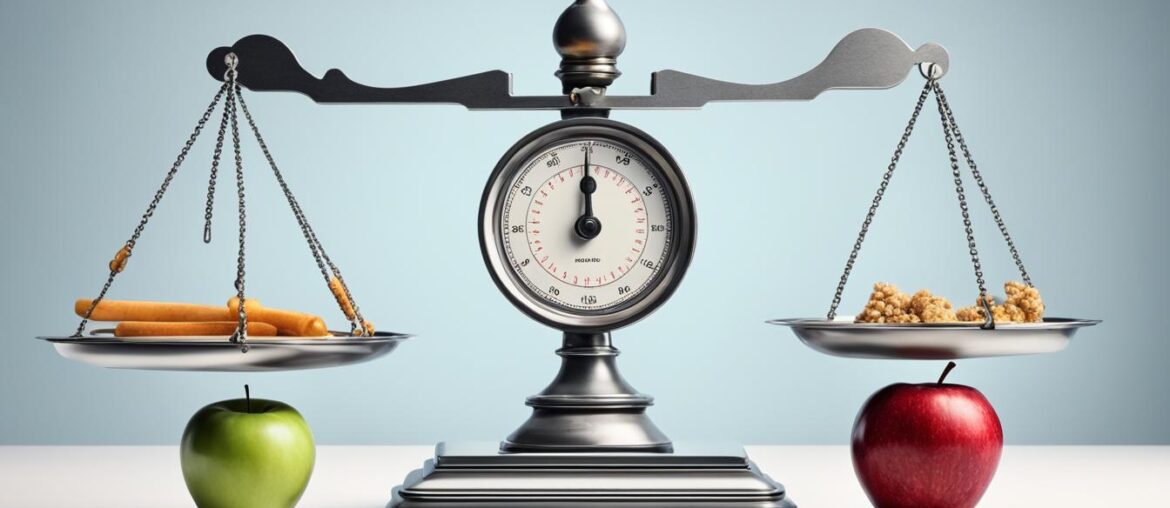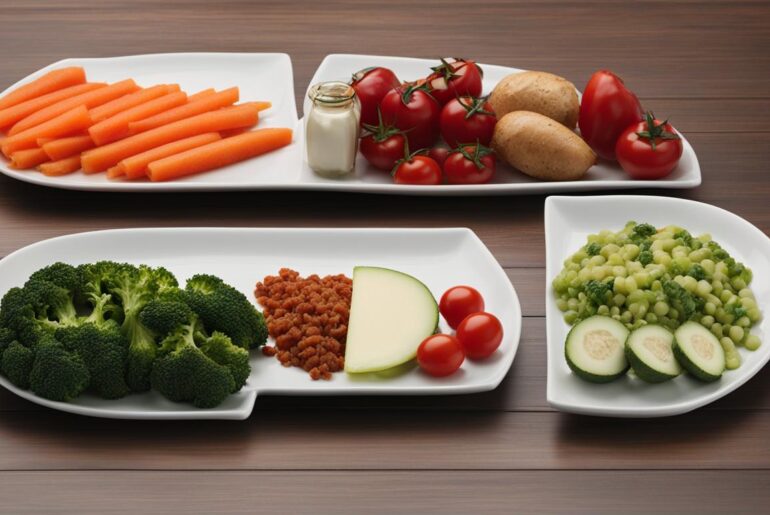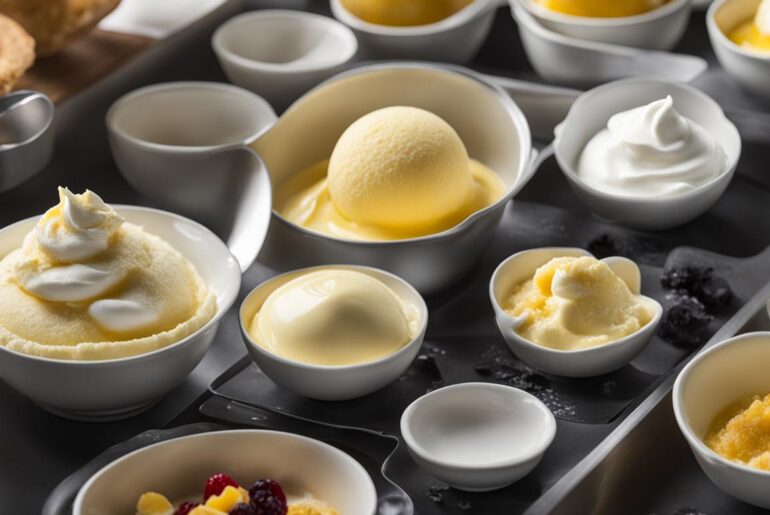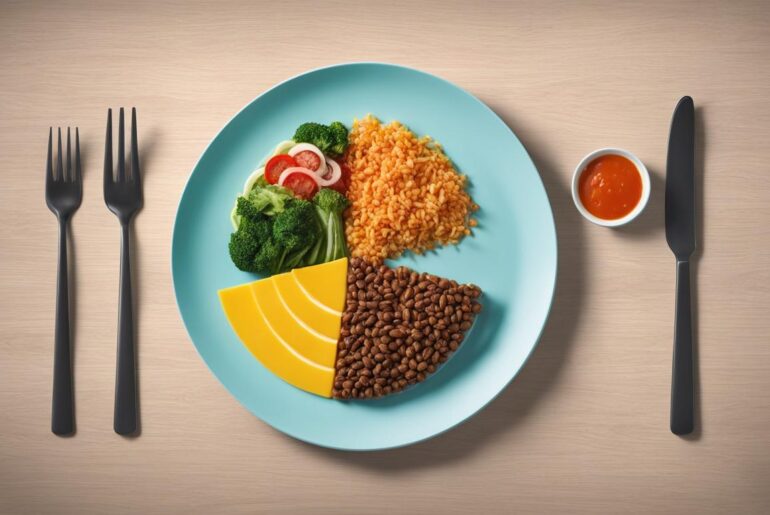Portion control is an essential aspect of maintaining a balanced lifestyle and achieving effective weight management (check this post out). By implementing the right strategies, you can learn how to control your portion sizes and make healthier choices. Here are some tips and techniques to help you get started on your portion control journey.
Key Takeaways:
- Start your portion control journey to maintain a balanced and healthy lifestyle.
- Use a smaller plate to prevent overloading and feel satisfied with smaller portion sizes.
- Try using measuring cups to accurately measure your portions and ensure you are eating the right amount every time.
- Opt for healthier options such as fruits instead of high-calorie desserts for seconds.
- Check food labels to determine portion sizes and be mindful of serving sizes mentioned on nutrition labels.
Use a Smaller Plate
When it comes to portion control, one simple strategy that can make a big difference is using a smaller plate. By opting for a smaller plate, you can effectively manage your portion sizes and prevent overloading.
Using a smaller plate can create an optical illusion, making a standard-sized portion appear larger. This visual trick can help you feel more satisfied with smaller amounts of food, as your brain perceives the plate to be full.
Research shows that when people use larger plates, they tend to serve themselves more food and consume larger portions, leading to overeating and potential weight gain.
By consciously choosing a smaller plate, you can control your portion sizes and create a more balanced approach to your meals. It allows you to focus on quality rather than quantity and encourages you to savor each bite.
Remember, it’s not about depriving yourself; it’s about finding a healthier balance. Using a smaller plate can help you feel satisfied with smaller portions, preventing overloading and promoting portion control.
Give Measuring Cups a Go
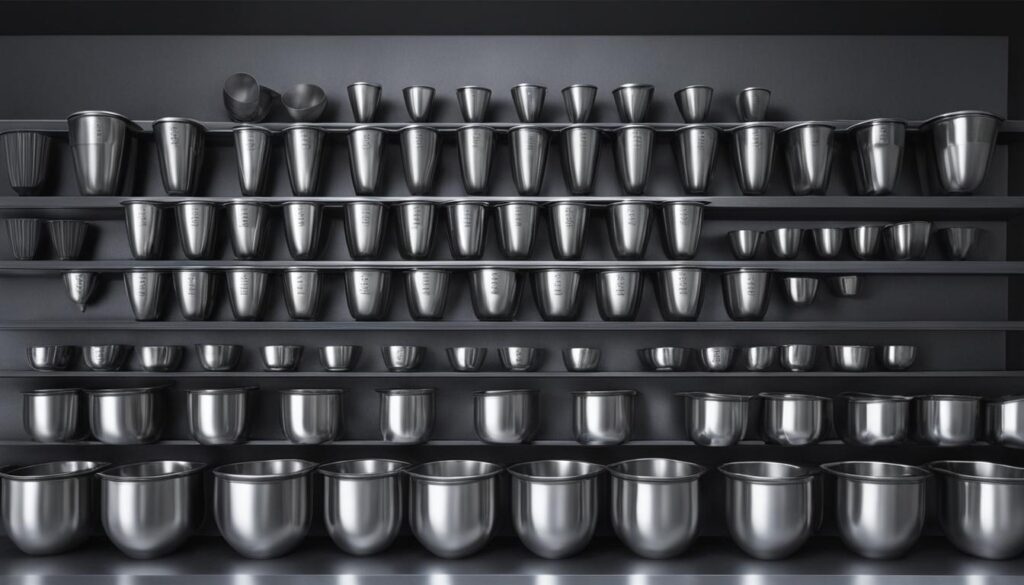
If you find it difficult to gauge the right amount to eat, try using measuring cups. Measuring cups can provide a simple way to accurately measure your portions and ensure you are eating the right amount every time.
When it comes to portion control, accuracy is key. By using measuring cups, you can take the guesswork out of portion measurement and achieve more precise control over your food intake. Whether you are cooking a recipe or serving yourself a meal, measuring cups offer a reliable tool to help you maintain portion consistency.
Using measuring cups is particularly useful for foods that are not easily visualized or measured by eye, such as dry ingredients, liquids, or snacks like chips or pretzels. By measuring your portions with cups, you can track and manage your calorie intake more effectively.
Here’s an example of how using measuring cups can make a difference: let’s say you’re preparing a bowl of cereal for breakfast (check this post out). Without using measuring cups, you might pour more cereal than necessary, leading to an inflated portion and increased calorie intake. However, with measuring cups, you can accurately measure the recommended serving size, ensuring you start your day with a balanced and controlled portion.
Not only do measuring cups help with accurate portion control, but they also promote mindful eating habits. When we take the time to measure our food, we become more aware of the quantity we consume. This mindful approach encourages us to savor each bite and be more conscious of our satiety cues.
| Benefits of Using Measuring Cups for Portion Control |
|---|
| 1. Accurate portion measurement |
| 2. Promotes mindful eating habits |
| 3. Helps manage calorie intake |
| 4. Ensures portion consistency |
Incorporating measuring cups into your portion control routine is a simple yet effective strategy for maintaining a balanced diet. By accurately measuring your portions, you can achieve your health and weight management goals with confidence while still enjoying the foods you love.
Be Selective with Your Seconds
When it comes to portion control, making smart choices during mealtime can make a significant difference. Instead of indulging in high-calorie desserts like chocolate cake for seconds, opt for healthier options such as fruit. Not only will choosing fruit over chocolate contribute to a more nutritious and balanced diet, but it can also help you manage your calorie intake more effectively.
Fruit is not only delicious but also packed with essential vitamins, minerals, and fiber that promote overall health and well-being. Compared to chocolate, fruits are generally lower in calories and higher in nutrients, making them a healthier choice for those looking to control their portions and maintain a healthy weight.
Let’s take a closer look at a calorie comparison between a popular fruit, the apple, and a decadent chocolate cake:
| Fruit | Calories per serving |
|---|---|
| Apple | 52 |
| Sweet Treat | Calories per serving |
|---|---|
| Chocolate Cake | 352 |
As you can see from the calorie comparison, indulging in an apple provides you with a satisfying snack option that won’t derail your calorie goals. Consuming fewer calories while feeling full and satisfied can help you maintain a healthy weight and promote overall well-being.
Here’s a simple breakdown:
- An apple contains only 52 calories per serving.
- A serving of chocolate cake, on the other hand, racks up a whopping 352 calories.
By consciously choosing healthier options like fruit over high-calorie treats like chocolate cake, you can enjoy seconds guilt-free while still adhering to your portion control goals.
Remember, making mindful and selective choices during your meals can help you achieve your portion control objectives while maintaining a balanced and healthy lifestyle. Embrace the power of healthy options and experience the benefits of prioritizing nutrient-dense foods in your diet.
Check Food Labels
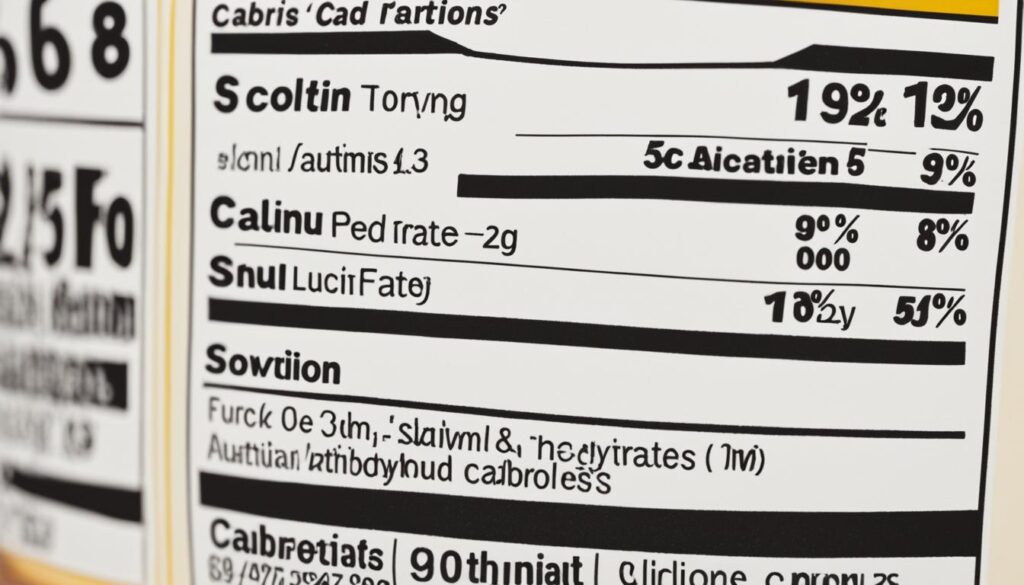
When grocery shopping, it’s important to check the nutrition information on food labels to determine the portion size. The serving size mentioned on the label may be different from the amount you normally serve yourself, so being aware of this can help you control your portion sizes more effectively.
Food labels provide valuable nutrition information that can guide your portion control efforts. By reading the labels, you can understand the composition of the food you’re buying and make informed choices about portion sizes.
Here are some key details to look for on food labels:
- The serving size: This indicates the recommended amount per serving. Pay attention to the serving size because it affects the accuracy of the nutrition information.
- Nutrient quantities: Food labels provide information on the amount of calories, fats, carbohydrates, proteins, and various other nutrients per serving.
- Percentage daily value (%DV): This percentage represents how much of the daily recommended intake of a particular nutrient is provided by one serving. It can help you gauge if a food is high or low in a specific nutrient.
Remember that food labels are based on standardized serving sizes and may not reflect your individual needs. It’s crucial to adapt the serving sizes according to your specific nutritional requirements and portion control goals. Use the nutrition information as a guide to help you make healthier choices and manage your portion sizes more effectively.
| Product | Serving Size | Calories | Total Fat (g) | Carbohydrates (g) | Protein (g) |
|---|---|---|---|---|---|
| Frozen Yogurt A | 1/2 cup | 100 | 2 | 18 | 4 |
| Frozen Yogurt B | 1 cup | 200 | 4 | 36 | 8 |
The table above demonstrates the importance of checking serving sizes on food labels. As shown, the serving size of Frozen Yogurt A is 1/2 cup and contains 100 calories, while Frozen Yogurt B has a serving size of 1 cup and contains 200 calories. By being mindful of serving sizes, you can make more informed choices when it comes to portion control.
Conclusion
Portion control is an essential practice for maintaining a healthy weight and promoting overall well-being. By implementing various strategies, you can successfully regulate your portion sizes and make healthier choices in your daily diet.
Using smaller plates is a simple yet effective technique to control portion sizes. It tricks your mind into perceiving a standard-sized portion as more substantial, preventing overloading and promoting a feeling of satisfaction with smaller amounts of food.
Another helpful tool is using measuring cups to accurately measure your portions. This ensures that you are eating the right amount and allows for more precise portion control.
Additionally, being selective with seconds can significantly impact your overall calorie intake. Opting for healthier options like fruits instead of high-calorie desserts like chocolate cake offers more satisfaction while consuming fewer calories.
Checking food labels and being mindful of serving sizes are crucial steps for effective portion control. By paying attention to nutrition information and serving sizes, you can make informed choices and successfully control your portion sizes in line with your health goals.
Embark on your portion control journey today and experience the benefits of a balanced and healthy lifestyle. With strategies like using smaller plates, measuring cups, and being selective with seconds, you can achieve optimal portion control for healthy eating.

